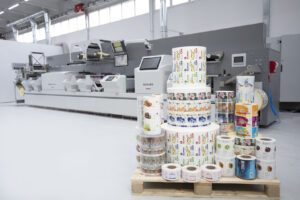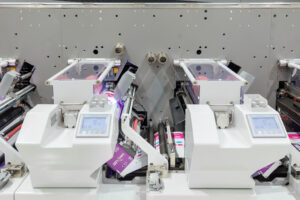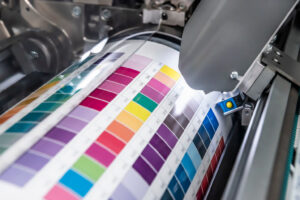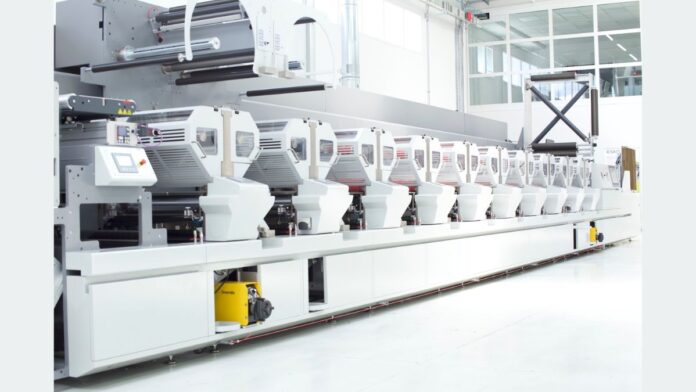Label converters face challenges from many different directions that directly threaten the profitability of their businesses. However, despite pressures on price and severe labor shortages, combined with the need to adapt quickly to new market trends while delivering high quality labels, there are still opportunities to grow for those ready to embrace the world of digitalization, automation and connectivity.
Following a contraction of the label market in 2023, volumes returned to more normal levels in 2024, according to Smithers: “The Future of Printed Labels to 2029”. Even better news, the report predicts a compound annual growth rate (CAGR) in value of 4.6% which is equivalent to 4.4% in volume terms. But competition is fierce, and costs are rising, meaning converters must implement solutions that simplify label production to capitalize on this growth and safeguard dwindling profit margins.
Mitigating the skills drain
Label converters operate in a dynamic market that requires a high level of agility to respond to brand owners’ demands for rapid turnaround, shorter run lengths, and excellent quality. However, the industry faces a growing shortage of skilled operators and a knowledge transfer gap due to fewer young people entering the field. Without experienced staff to run the presses and operate the finishing machines, the industry must look to technology to maintain standards.
One of the major pain points compounded by the skills drain is ensuring color consistency – not only over time but also across different printing technologies and applications. Meanwhile, the increasing emphasis on sustainability, including waste reduction and the use of new eco-friendly materials, adds a significant dimension to an already complex situation.
We are seeing the industry addressing these issues from a product and process point of view. The main trend can be observed in digital printing with a move towards automated inline processes. Here, end-to-end or ‘All-in-One’ workflows are gaining ground. Already in use by most medium to large converters, these advanced integrated solutions are capable of producing ready-to-ship labels in one pass with a single person operating the entire line.
Digitalization on the flexo front

Narrow web flexo technology is also being further optimized by incorporating higher levels of automation and digitalization to improve efficiency and minimize waste, regardless of the machine operator’s skills or qualifications. It is important to note that flexo remains the primary technology for label production in the short to medium term, accounting for nearly 40% of the market volume in 2023 according to Smithers.
Operating old flexo presses is an art in itself, so with the number of experienced operators falling rapidly, companies must move to more automated solutions to ensure output quality. BOBST is already well regarded for its highly automated inline flexo presses with innovative features such as DigiFlexo and DigiGap ensuring automatic register and pressure adjustment, automatic job change, and high-performance semi-rotary die-cutting with automatic die-plate change, amongst others.
Increasing sustainability with oneECG

We are now witnessing a rising interest in oneECG, BOBST’s proprietary solution for extended color gamut printing. Through the digitalization of color information (following a very similar process in digital printing which by default utilizes ECG), converters can ensure highest color repeatability between jobs and between flexo and digital technologies, faster and more efficiently. oneECG for inline flexo not only improves productivity by 67%, but it also has a positive impact on sustainability, reducing setup waste by up to 65%, as well as lowering energy consumption and ink waste.
Converters look to oneECG not only to reduce their environmental footprint but also to streamline operations. In combination with automatic job change, flexo machines like the BOBST MASTER M6 become not digital, but highly digitalized. Implementing oneECG in narrow-mid web flexo is particularly effective for applications such as shrink sleeves and other flexible packaging. These are areas where job lengths are reducing but not to the point where digital technology is cost-effective.
Mastering digital inline operation
The transition to All-in-One operation, where labels are produced on one machine that incorporates digital and flexo printing, embellishment, die-cutting and quality control, is ramping up, driven by the need to deliver exceptional quality at speed with the lowest possible amount of waste and at competitive costs.
Configurable with any number of value-adding modules, the DIGITAL MASTER modular platform from BOBST gives converters the capability to produce a much wider variety of superior quality products. Complex applications, such as multilayer labels, highly embellished labels, to name a few, can be much more effectively produced on these presses.
By eliminating idle time between processes and reducing complexity in planning, DIGITAL MASTER ensures faster turnaround thereby speeding up time-to-market. Combining multiple processes in one machine also reduces the need for additional equipment, such as offline embellishment machines, and operators, which lowers the overall production costs, simplifies the workflow and optimizes the factory floor.
Next-level inspection with ACCUCHECK

A key aspect of the All-in-One platform that brings digitalization and automation to a new level is BOBST ACCUCHECK. Much more than a simple inspection system, ACCUCHECK is unique in the industry due to its close integration with the press software which offers full control over the entire process. This is only possible because all the modules have been developed in-house, including the DPU, inspection, calibration, and press software. Time-consuming processes, such as uniformity and color-to-color calibration that used to take hours, can now be performed in a matter of minutes.
ACCUCHECK is the first inspection system on the market that automatically sets up every job and synchronizes with the job queue, meaning that the quality of the output is evaluated based on objective parameters. The system also supports the use of less experienced operators to ensure that productivity is in fact increased, while needing fewer people to run the presses.
Closing the workflow loop with BOBST Connect
In general, the main benefits of digitalization and automation can be summed up as follows:
- Driving efficiencies and productivity
- Guaranteeing quality and consistency
- Mitigating staffing challenges
- Improving sustainability through waste reduction
- Enabling a connected workflow
With this in mind, at BOBST, we are focusing our efforts on the development of automated, digitalized and connected solutions. The aim is to provide the highest ease-of-operation by leveraging a closed loop workflow infrastructure through Bobst Connect, the cloud-based platform created for a seamless entry into the data-driven world.
BOBST Connect enables the connectivity between machines, the digitalization of processes, and the automation of workflows, all in real-time. Converters can view and analyze OEE trends, track job progress, and easily monitor trends over time. This information is crucial for optimizing productivity, improving machine performance, and eliminating waste.
This is the BOBST vision – a fully connected workflow from job PDF to final twin PDF, where with every job we print, we learn more to continually improve the way we work.
Label production in the future
Looking ahead, we foresee that labels will increasingly be produced in a single pass due to the trends discussed above. BOBST’s inline flexo & All-in-One presses are designed to be future proof ensuring that our customers stay ahead of the curve and can adapt to the evolving market needs with confidence.
Further ahead, smart factories are on the horizon. While for the moment the concept of fully automated label production is visionary thinking, we are closing the gap step by step. Technology has reached a high standard, the next level in innovation lies in optimizing the processes, streamlining operations and connecting the dots between different workflow steps.
VOICE OF THE CUSTOMER
“A core development focus for our operations, like many businesses in our industry, lies in automation. By creating a more connected workflow, we not only improve efficiency but empower our operators to accomplish more.
“Being an early adopter of the All-in-One solution has allowed us to remain competitive and sustainable, streamlining operations due to the close integration of flexo, digital, and converting technologies.”
Cees Schouten, COO
Geostick, The Netherlands
“BOBST technology enables Eticod to produce beautiful designs and complex labels while also reducing waste. Our operators can control the press digitally, while the inline inspection system identifies errors and automatically locates faulty labels on the re-winder. And that all happens in one single pass, which saves a lot of time.”
Aron Huc, Vice President of the Management Board and Co-Owner
ETICOD, Poland
“The throughput speed of up to 200 m/min [of the BOBST MASTER M5] is already impressive, but our set-up time has reduced by 30%, compared to our outgoing machine. We anticipate more advantages with the inclusion of oneECG technology. Digital printing technology has made customers more impatient, and that puts a lot of pressure on conventional converters. With our new investment, we’re stabilized and ready to respond to the ‘now’ culture.”
Kevin Paszek, Managing Director
Tungate Group, England
“Every time you have people involved, there is a risk of errors being introduced, so it’s really a game changer for our company to automate the workflow, because everyone’s forced to work in the most optimal way. I anticipate that by the end of the year, faults caused by human error will be down to less than 1%, which adds to our profitability, as well as saving loads of waste.”
Theis Bach Carlsen, Managing Director
ScanLabel, Denmark












